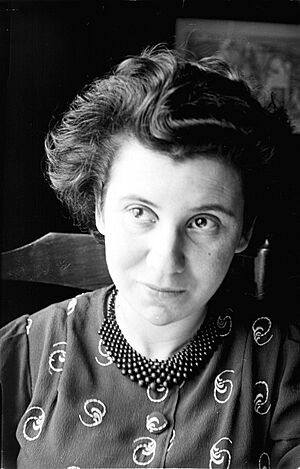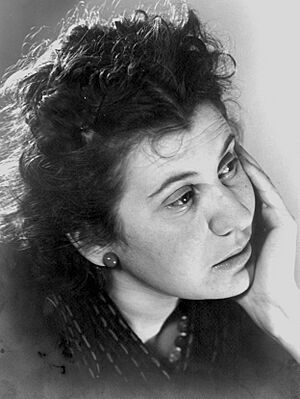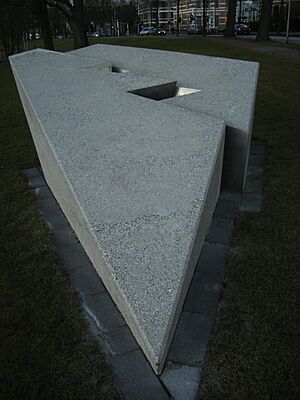Etty Hillesum facts for kids
Quick facts for kids
Etty Hillesum
|
|
|---|---|

Hillesum in 1939
|
|
| Born |
Esther Hillesum
15 January 1914 |
| Died | 30 November 1943 (aged 29) Auschwitz-Birkenau, German-occupied Poland
|
| Nationality | Dutch |
| Occupation | Writer |
| Known for | Diary and letters from camp Westerbork |
Esther (Etty) Hillesum (born January 15, 1914 – died November 30, 1943) was a Dutch Jewish writer. She wrote many letters and diary entries. These writings show her journey of faith and how Jewish people were treated badly in Amsterdam during World War II. In 1943, she was sent to a concentration camp and died there.
Contents
Etty Hillesum's Life Story
Esther (Etty) Hillesum was born on January 15, 1914, in Middelburg, Netherlands. She was the oldest of three children. Her brothers were Jacob (Jaap) and Michael (Mischa).
After finishing school in 1932, Etty moved to Amsterdam. She studied law and Slavic languages there. She also met Hendrik (Hans) J. Wegerif, and they had a relationship.
How Etty Started Writing Her Diary
Etty Hillesum began writing her diary in March 1941. This might have been suggested by her therapist, Julius Spier. Etty worked for him as a secretary and became his friend. He helped her learn about the Bible and St. Augustine. He also helped her understand writers like Rilke and Dostoyevsky better.
Her diaries show how the German army made life harder for Jewish people. They also show how worried everyone was about Jews being taken away. Besides recording these hard times, her diaries also describe her own spiritual journey and her growing faith in God.
Working at Westerbork Camp
In July 1942, more and more Jewish people were being rounded up. Etty started working for the "Jewish Council". She chose to work in a special department at the Westerbork transit camp. This department helped people who were being moved through the camp.
She worked there for a month. Later, in June 1943, she returned to the camp. Her non-Jewish friends wanted her to hide, but she refused. Etty believed it was her duty to help and support others who were being sent from Westerbork to concentration camps.
On July 5, 1943, Etty became a prisoner in the camp. Her father, mother, and brother Mischa were also held there.
Deportation and Death
On September 7, 1943, Etty and her family were sent from Westerbork to Auschwitz. Her brother Jaap was not with them. He arrived at Westerbork later and was sent to Bergen-Belsen. He died shortly after that camp was freed in April 1945.
Etty Hillesum's parents died on September 10, 1943. This means they likely died during the journey or were killed right after arriving. Mischa Hillesum stayed in Auschwitz until October 1943. He was then moved to the Warsaw Ghetto and died there before March 31, 1944. Etty herself was killed in Auschwitz on November 30, 1943.
Etty's Inner Strength and Ideas
Etty Hillesum's early life was sometimes difficult and confusing. She even called her family home a "madhouse." Her diaries show the struggles she faced when she was young. They also show how she grew stronger and wiser in the years before she died.
Finding Meaning in Hard Times
Etty was inspired by Russian writers and Christian thinkers. She wanted to understand her deepest self and life itself. Her spiritual ideas were not just thoughts; they were part of her daily life. Even in the Westerbork camp, she had amazing spiritual experiences. She wrote: "Those two months behind barbed wire have been the two richest and most intense months of my life... I have learnt to love Westerbork."
Hillesum often spoke to God in her diaries. She saw God not as someone who would save them from their situation, but as a power that people must keep alive inside themselves. She wrote: "You cannot help us, but we must help You and defend Your dwelling place inside us to the last."
Seeing Beauty Amidst Horror
While still in Amsterdam, Etty developed a way of thinking about helping others find their inner strength. This was especially important during the terrible time of Nazi rule. Her time at Westerbork, as shown in her diaries, reveals how her spirit became free, even though her body was held captive.
She did not ignore the horrors of the Nazi terror. But she also did not see herself only as a victim. Even in extreme conditions, Etty became aware of the lasting beauty in the world. She wrote from Westerbork: "The sky is full of birds, the purple lupins stand up so regally and peacefully... the sun is shining on my face – and right before our eyes, mass murder... The whole thing is simply beyond comprehension." Etty kept writing with great kindness, understanding, and deep thought.
Etty Hillesum faced much inner struggle when she was young. But she slowly became a very wise woman. She wrote: "Everywhere things are both very good and very bad at the same time. The two are in balance, everywhere and always." She felt connected to a bigger picture and found meaning in her difficult reality. Etty believed it was her duty to help her people keep their human dignity. This was important because the Nazis tried to take away not only their lives but also their humanity.
On September 7, 1943, less than three months before she died, she threw a postcard from a train. It had her final words: "Opening the Bible at random I find this: 'The Lord is my high tower'. I am sitting on my rucksack in the middle of a full freight car... We left the camp singing... Thank you for all your kindness and care."
Etty Hillesum's Diaries and Letters
Before she left for Westerbork, Etty Hillesum gave her diaries to a friend, Maria Tuinzing. She asked that they be given to Klaas Smelik to be published if she did not survive. It was hard to get them published at first. But in 1979, Smelik's son, who led the Etty Hillesum Research Centre, found a publisher.
A shorter version of her diaries came out in 1981. It was called Het verstoorde leven (An Interrupted Life). Later, a collection of her letters from Westerbork was also published. A full version of all her letters and diaries came out in Dutch in 1986. It was translated into English in 2002. Her diaries have been translated into 18 languages. Her letters were sent to friends. Etty's last postcard was thrown from the train in Westerbork. Dutch farmers found it after her death.
What Others Say About Etty
Many people have been inspired by Etty Hillesum's writings.
- David Brooks admired how Etty could be both thoughtful and caring, even in very hard times.
- Richard Layard appreciated Etty's idea that people must protect their inner self.
- Rowan Rheingans used Etty's writings in her album "The lines we draw together." She focused on how beauty and horror can exist together.
- The poet Doron Braunshtein wrote a poem for Etty called "Etty Hillesum is my life".
- Palestinian writer Dina Awwad-Srour and Israeli Rabbi Emma Sham-Ba Ayalon created Etty Hillesum cards. These cards have quotes from Etty's writings in English, Hebrew, and Arabic. They use these cards for a special event on Holocaust Memorial Day.
Research Centre and Museum
On June 13, 2006, the Etty Hillesum Research Centre (EHOC) opened at Ghent University. This center studies and promotes research on Etty Hillesum's World War II letters and diaries.
The Centre is led by Klaas A.D. Smelik. He was the one who edited and published the complete edition of her letters and diaries.
There is a monument to Etty Hillesum in Deventer by the river. Local schools are also named after her. There is also a small museum dedicated to her memory. It is called the Etty Hillesum Centre. It is located at Roggestraat 3, Deventer, which used to be a synagogue and a Jewish school.
See also
 In Spanish: Etty Hillesum para niños
In Spanish: Etty Hillesum para niños
- List of Holocaust diarists
- List of posthumous publications of Holocaust victims
- Helga Deen – wrote a diary in 's-Hertogenbosch concentration camp (Camp Vught)
- List of Dutch Jews
- List of diarists



